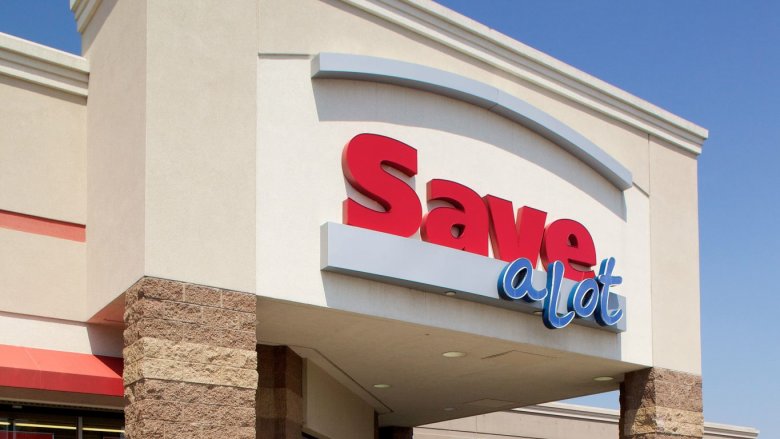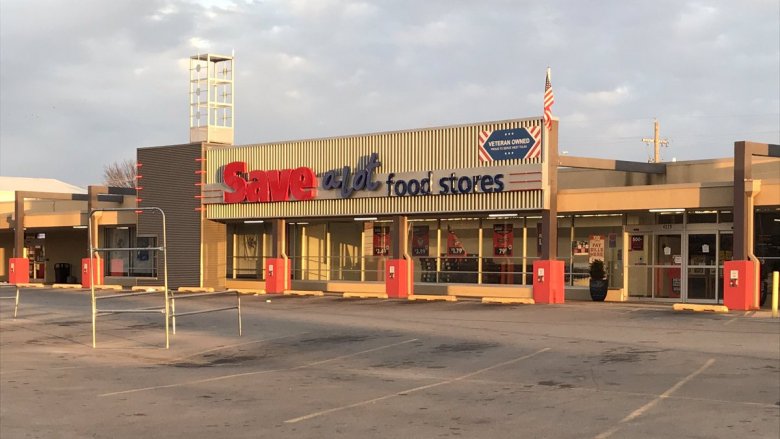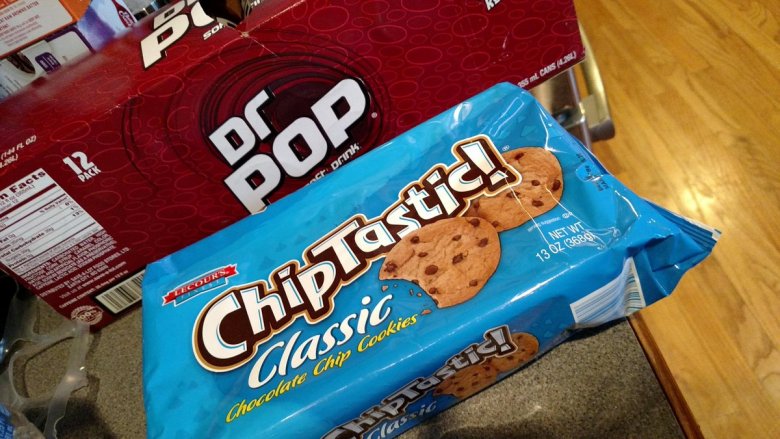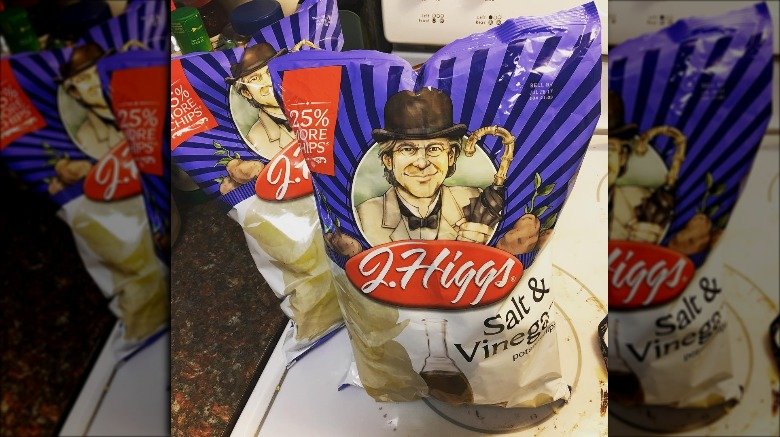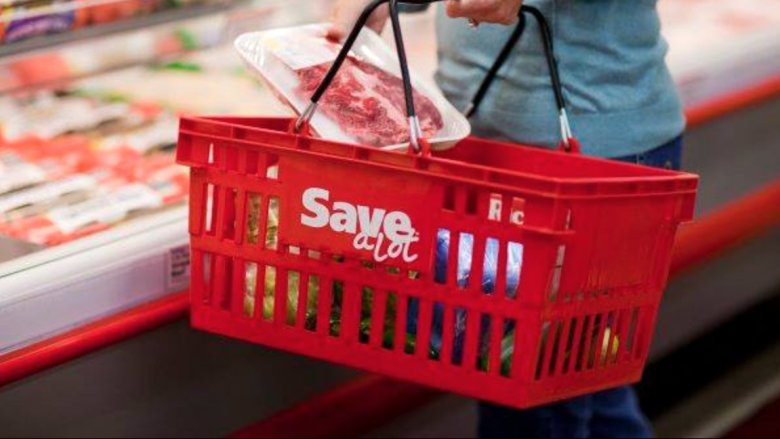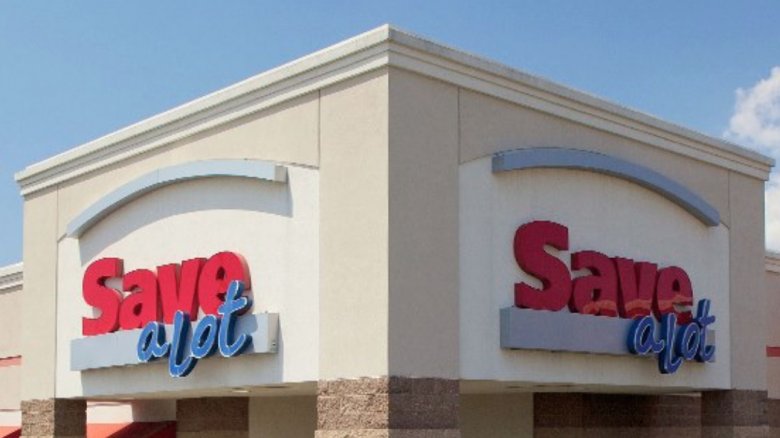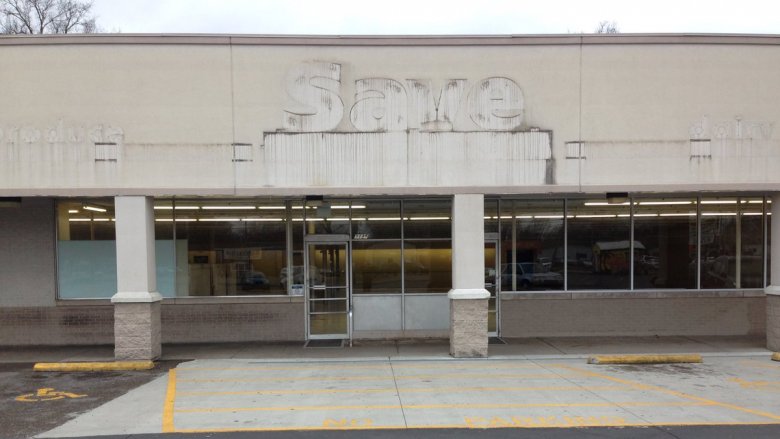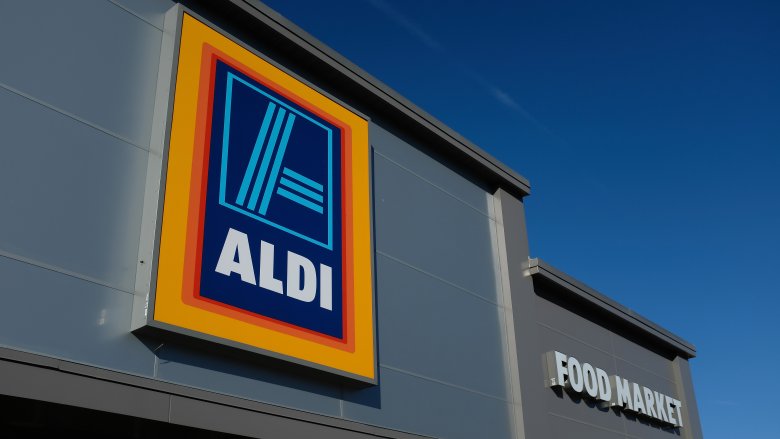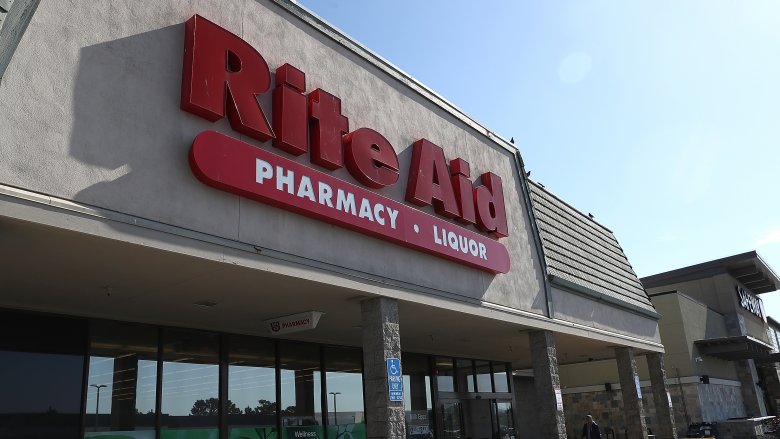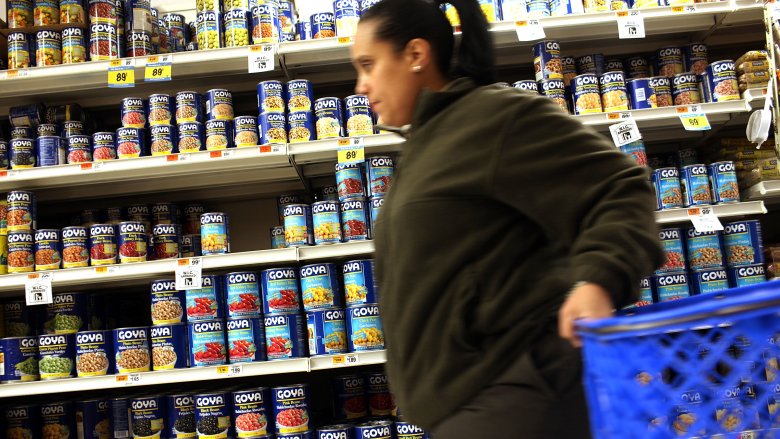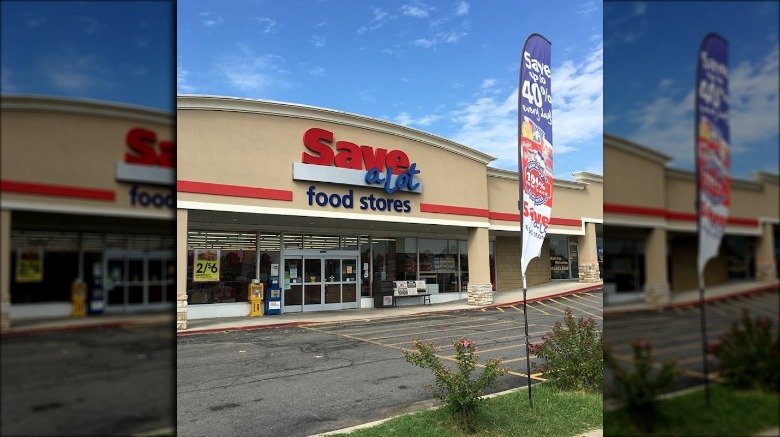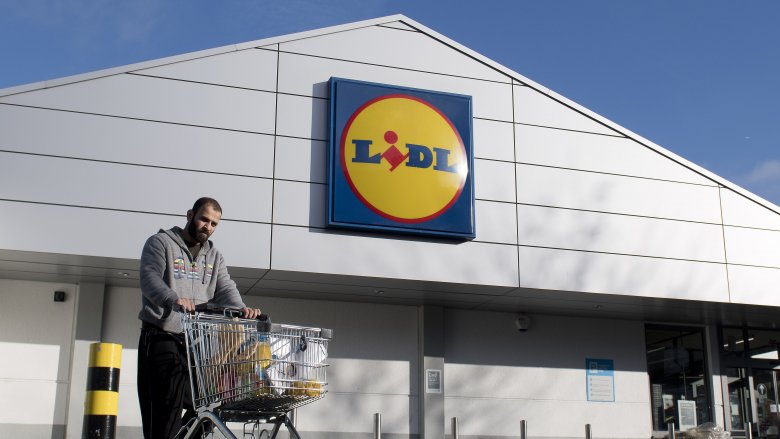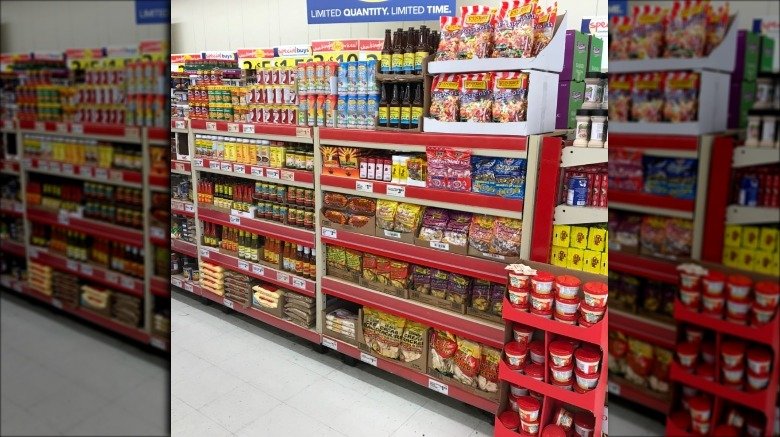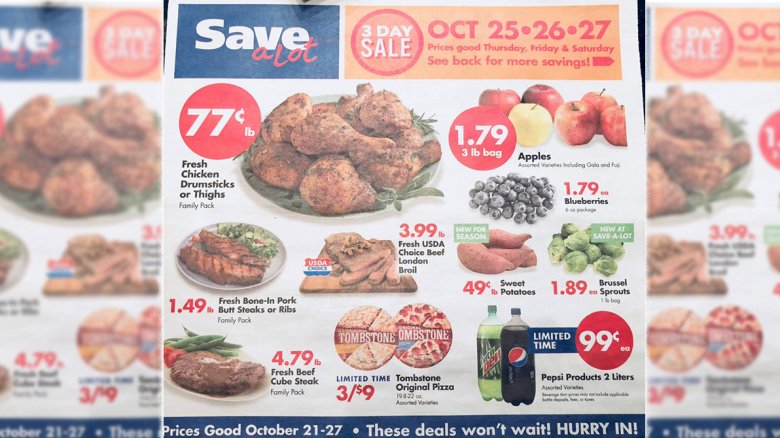The Untold Truth Of Save-A-Lot
Even if you don't shop at Save-A-Lot, you've probably at least driven by a few of these small scale grocery stores that are sprinkled throughout the landscape of the United States. They aren't known for having full-service delis or pharmacies the way the bigger stores like Albertsons and Kroger are. In fact, their whole model has been pretty bare bones for the past four decades and that's exactly the way they like it.
That model of having smaller stores with a limited selection of brands and items has served Save-A-Lot well. They're known as a cost-effective place to shop, and often can be found in communities undeserved by the larger grocery chains. All is not entirely well for Save-A-Lot though, and in recent years they've struggled with expanding competitors and corporate shakeups. But the Missouri-based grocery chain isn't going down without a fight. Let's take a look at the untold truth of this grocery store that's all about giving people the basics at low prices.
They were a pioneer in small grocery strategy
Small scale grocery stores are becoming more commonplace in today's grocery market with chains like Aldi and Dollar General expanding into more regions across the United States. In terms of who started this trend first, most of that credit should be directed at Save-A-Lot — at least when it comes to the U.S.
It all started back in 1977, when Bill Moran, a former marketing executive in the grocery business, opened an alternative to the big grocery chains in Cahokia, Illinois. Of course, small mom-and-pop grocery stores have been around for decades, but Moran wanted to bring the chain concept of the small grocery store, as was popular in Europe, to the U.S. Compared to the bigger stores like Kroger and Publix, Moran's new stores would be smaller in nearly every way. Building sizes were around 15,000 square feet or "about the size of two Krispy Kreme doughnut stores" as one profile piece put it, and had fewer items as well. Whereas a larger grocery store like Harris-Teeter might have 35,000 items, Save-A-Lot stores carry around 1,250.
They prioritize their own brand over national brands
If you're new to shopping at Save-A-Lot, you won't make it too far down the first aisle before you notice something a little different: You won't recognize most of the brand names. Sure, you might see a few familiar brands like Hershey's Kisses or Banquet frozen dinners, but how about Lecour's Finest Creme Betweens? Have you ever heard of Kiggins Hoot'n Honey cereal?
Part of the secret to keeping their prices so low is selling only the most purchased items and selling their own brands. "We carry one size and one variety of each item," Save-A-Lot communications manager Dan Kimack said. "If it's a can of whole-kernel corn, it's going to be one size and one variety, and it's going to be the most popular size and variety."
Make no mistake about it — limited brands doesn't mean limited items. In fact, there are more than 100 brands in the store that the chain can count as its own. So while Save-A-Lot may not have 15 national brand varieties of oatmeal to choose from, the limited variety they do carry ensures a lower bill upon checkout.
Their brand names have special meaning
While we're on the subject of Save-A-Lot's brands, let's take a moment to talk about those names. What's going on with some of those in-store brands like Grissom's Mill and Tipton Grove?
Ask any first-year marketing major and they'll tell you that most companies spend a lot of time deciding what to name their various products, and Save-A-Lot is no different. Their exclusive brands account for the majority of what's on the shelf, and it turns out that many of them are named after store and company employees.
For example, the McDaniel's coffee products pay tribute to an employee named David McDaniel, and the store's line of Shaner's frozen chicken products take their name from then-CEO Bill Shaner. The company prides itself not only on naming their own products, but also designing their own packaging in-house. "Through package design, we will continue to communicate our product quality at a fantastic price," Shaner told Store Brands. "Each product is like a work of art."
Calling Kiggins Captain Chocs cereal a work of art might be a stretch, but if it keeps the prices low, keep doing your thing, Save-A-Lot.
They serve communities that bigger chains ignore
If Whole Foods is marketing itself to higher-income shoppers obsessed with organic produce, Save-A-Lot is at the other end of that spectrum. The particular demographic that Save-A-Lot is going after are the shoppers many grocery chains overlook — folks on a fixed income who don't want to comb through 20 aisles at Walmart for groceries.
"I'm on disability and really have to watch how I spend my money," shopper Betty Duffey told the Tampa Bay Times. "At Publix, I'd spend $200 a month for groceries. At Winn-Dixie, I'd spend probably around $150. But at Save-A-Lot, I'll spend $80 for the same amount of food."
Save-A-Lot's stores are often in lower-income neighborhoods where many of their shoppers have incomes under $35,000 and depend on having a grocery store that doesn't require a 10-minute drive. "Our goal is to be a neighborhood grocery store, which means we serve people who live within two to three miles of the store," company spokesperson Chon Tomlin said.
And when a store closes, it can be especially hard on residents of the area who depend on it. "It is disappointing to lose a grocery store that serves a large neighborhood," county economic development manager Dianna Cantler said after the 2018 closure of a Save-A-Lot in Johnson City, Tennessee. "Once again, the North Side community will be a food desert, with nothing within a walkable distance."
One of their executives was accused of stealing secrets
You don't need an MBA to know that stealing company secrets from your old job and bringing them to your new job is a business no-no. Former Save-A-Lot employee Thomas Altadonna might have missed that memo though, because in September 2018 he was accused of doing just that.
A lawsuit was filed by Save-A-Lot, alleging that while working as director of market development for the grocery chain, Altadonna emailed 2,000 pages worth of confidential company information to his personal email account over the course of three days. Just a few days later, he left his job after 24 years of employment to take a job with competitor Associated Wholesale Grocer.
Not only did Altadonna find himself hit with an $11,00 breach of contract lawsuit for "misappropriating confidential trade secrets," but the suit also claimed he was in breach of a signed contract to not work for an area competitor for at least one year after leaving Save-A-Lot. The store also asked for the court to award damages as they saw fit. A permanent injunction has since been issued on the case, but as of March 2019 there's no word on what the final settlement was.
Let this be a lesson, kids: There's a right way to exit a job, and very wrong way to exit a job.
They've struggled on the West Coast
Save-A-Lot wasted no time in establishing its grocery store foothold in the United States and had amassed more than 50 locations in its first three years of business. But most of those locations were in the Midwest and eastern part of the country. The company has expanded into the north and as far west as Colorado, but making itself a staple of West Coast shoppers has been largely unsuccessful. (Californians won't likely be abandoning their beloved Trader Joe's anytime soon.)
Save-A-Lot wanted to give West Coasters a shot at grabbing their low-priced cereals and other products with funky names, but it simply didn't pan out. The initiative began in 2015, and by early 2017, the company announced that it would be shuttering all of its California and Nevada locations, saying it would be "better served by investing in areas where its brand equity is already well-established." That's polite talk for "you don't want us; forget you then!"
It's probably a safe assumption that Aldi opening 45 stores in California around that same time didn't exactly set out the welcome mat for Save-A-Lot. "I'm not saying we won't ever go there, but there's a time and place for everything and this wasn't the time," then-CEO Eric Claus said.
They've struggled to compete with Aldi
Speaking of Aldi, the Germany-based chain seems to be the star quarterback of small grocery stores while Save-A-Lot seems perpetually stuck in second string. As of 2019, Aldi operated more than 1,600 stores in the U.S., with Save-A-Lot not terribly far behind at more than 1,300 stores. According to Supermarket News though, the big difference comes down to how much product each chain is pushing out the door. Aldi was far ahead in 2015 with their estimated sales coming in at $10.1 billion, more than double Save-A-Lot's reported $4.6 billion in sales for that same year.
Save-A-Lot tried what Supermarket News called "Aldi-like tricks" by creating the more streamlined and recognizable America's Choice brand, but that strategy probably isn't going to result in a sales boost worth billions of dollars.
One industry expert said part of the reason for Save-A-Lot's lag is the conditions of its stores. "It's too easy to find a beat-up Save-A-Lot store and it's hard to find a run-down Aldi store," analyst Chuck Cerankosky said. "There's some catch up needed at Save-A-Lot."
They attempted co-branded stores with Rite Aid
Part of Save-A-Lot's strategy for keeping prices low and appealing to its customer base has been cutting out in-store options like the full-service deli or pharmacy. The company attempted an experiment with adding a pharmacy — sort of — in 2010 when it signed a deal with pharmacy mega-chain Rite Aid to start co-branding certain locations.
Rather than invite Rite Aid to take up residence somewhere in an existing Save-A-Lot, it worked the other way around with the grocery chain moving into the front of Rite Aid stores, and existing Rite Aid pharmacies keeping their spots in the back. The locations were primarily in South Carolina, and offered a smaller selection of goods than a typical Save-A-Lot.
At the time, industry experts were optimistic about the corporate mashup. Grocery store analyst Gary Giblen wondered, "If a combination store can work by adding nonfoods to a supermarket, why shouldn't a smaller combo work adding a supermarket to a nonfoods store?"
The experiment wasn't destined for greatness however, and Rite Aid faced a restructuring and financial troubles in the years that followed. Out of the initial 10 Save-A-Lot/Rite Aid combo stores, it appears most of them are now out of business.
They have a line of stores aimed directly at Hispanic customers
2010 was definitely an experimental year for Save-A-Lot. The same year that it co-branded with Rite Aid in South Carolina, the grocery chain went after the Hispanic market in Houston and parts of South Texas.
The move came about when the grocery company teamed up with longtime Hispanic grocery operator Rafael Ortega of El Ahorro Supermarkets. The result was a new line of stores branded — what else? — El Ahorro Save-A-Lot. According to then-CEO Bill Shaner, the partnership was to help Save-A-Lot introduce itself to Texas' large Hispanic community.
According to El Ahorro's website, they focus on bringing their customers both "nostalgia and tradition" with an "extensive selection of sauces, jalapeño peppers, cookies, Mexican sodas, and all kinds of imported canned products." The grocery store coupling so far has proved more fruitful than the Rite Aid mashup, with El Ahorro Save-A-Lot still being in business as of 2019.
It's changed leadership a lot in recent years
From Save-A-Lot's earliest beginnings until the mid-2000s, founder Bill Moran was the head guy in charge. That changed though, when Moran retired from the company in 2006. Since then, the company has had trouble retaining a CEO for any length of time.
Moran's replacement Bill Shaner led the company for just five years before being replaced by Walmart executive Santiago Roces. A 2011 announcement said Roces would aid in accelerating Save-A-Lot's plans to more than double their number of locations, resulting in more than 2,400 stores by the end of 2015. But by January 2013, Roces was long gone and the company still had around 1,300 locations — some 1,100 off its lofty goal.
Roces lasted two years with Save-A-Lot before being replaced by Ritchie Casteel in 2013. Thankfully, Casteel stuck with the company and led it to new horizons — only kidding! He was out by early 2016, when former Red Apple CEO Eric Claus came in.
So why has Save-A-Lot's CEO office been a rotating door the past decade? Supermarket consultant David Livingston told the St. Louis Post-Dispatch in 2013 that he suspected they were hoping a turnaround specialist could right the ship. "But they have a massive amount of debt," Livingston said. "And they have some retail concepts that don't seem to be resonating with the consumer. So just having some new people in there isn't going to change that fact."
Can a former Lidl executive revive the chain?
As we said, Save-A-Lot hasn't exactly been able to save a lot of CEOs from jumping ship in the past decade. But the store's latest CEO may just stand the best shot at elevating the grocery chain's ranking in the market. Save-A-Lot was sold by Supervalu in late 2016 to Onex Corporation for $1.4 billion, and it wasn't long after that they brought in a secret weapon — an Aldi nemesis.
More specifically, that would be Kenneth McGrath, former CEO of Lidl, Aldi's main competitor in the European market. McGrath was instrumental in bringing Lidl into the U.S., and replaced Save-A-Lot's last CEO Eric Claus in April 2017. But what's better than one Lidl executive? Two of course. Also in April 2017, Save-A-Lot brought in Kevin Proctor, the former EVP of real estate at Lidl. As of March 2019, Proctor serves as Save-A-Lot's Chief Investment Officer.
The company hasn't explicitly laid out what McGrath's strategy will be, but it'll likely draw on what Aldi and Lidl have already done. "I think you're going to see Save-A-Lot turning back toward more traditional discount roots," Neil Stern of retail strategy firm McMillan Doolittle said. "I think obviously the model for them is and remains trying to get closer to replicating Aldi or Lidl..."
Considering that Save-A-Lot stores are drawing visual comparisons to Aldi, that seems to be the strategy.
They have low prices down to a science
By choosing to carry items like its own brand of Capri Sun called Splash Out!, Save-A-Lot is able to offer customers near identical products at a fraction of the cost they'd pay for a national brand. But it's not just the selling of its own brands that keeps prices low. Other factors are certainly at play in Save-A-Lot's recipe for customer savings.
For starters, those smaller stores mean that each location needs fewer employees to run the operations. Around 20 employees are needed at each store, versus Publix where stores might have hundreds of employees. It's the "lean efficiency" model that Save-A-Lot spokesperson Chon Tomlin said helps in keeping prices low.
Save-A-Lot also puts serious focus on making sure that unnecessary packaging doesn't result in an item's price ballooning. Because the company owns many of its distribution centers, they're able to do a lot of packaging without having to rely on shrink wrap. Products go right from their manufacturer to Save-A-Lot's distribution centers in the item carton case. This simplified system translates to lower costs for shoppers.
You should grab T'n'T items while you can
"Wait a second, Save-A-Lot didn't have Sun-Maid chocolate-covered raisins last week — what's going on?" Insert whatever national brand item you like, but just about every regular Save-A-Lot customer has probably wondered what's going on with the national brands that occasionally land on the store's shelves. One week they'll be there and then they'll be gone the next, returning months later or possibly — *gasp* — never.
If you do happen to spot a national brand on the shelf at Save-A-Lot, you'd better grab it while it's there. These items are called T'n'T — "Temporary 'n' Terrific" — and they're almost always only around for a limited time. "Probably 95 percent of our T'n'T items are national brands," division manager Mike Kelch said. "When we sell out of those items, they're gone. We may not get them back for months."
Something to keep in mind next time you're at Save-A-Lot.
